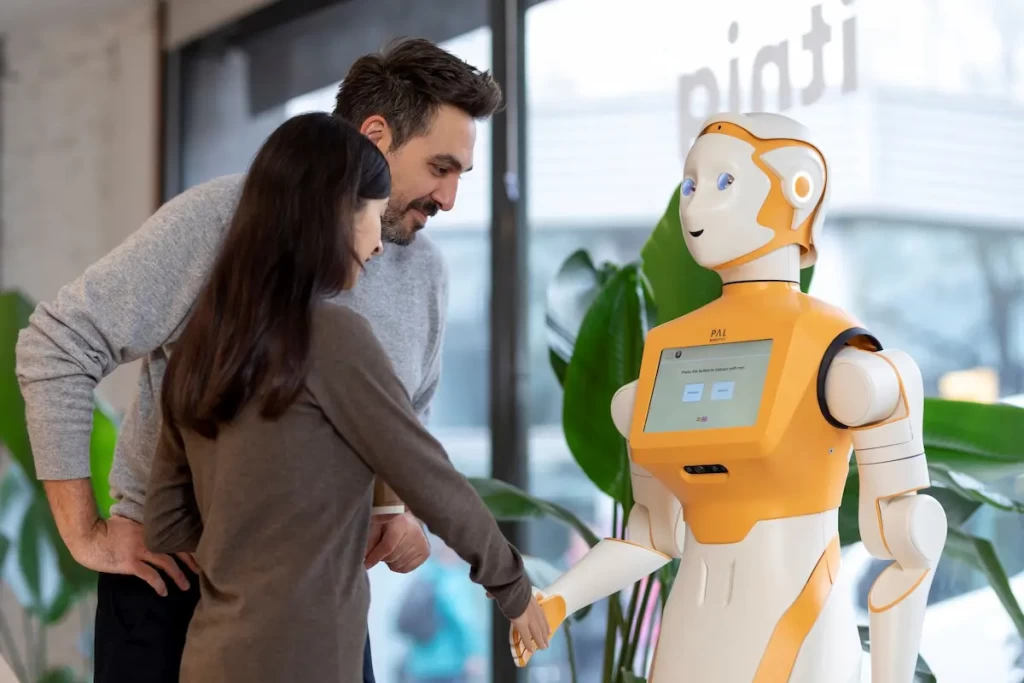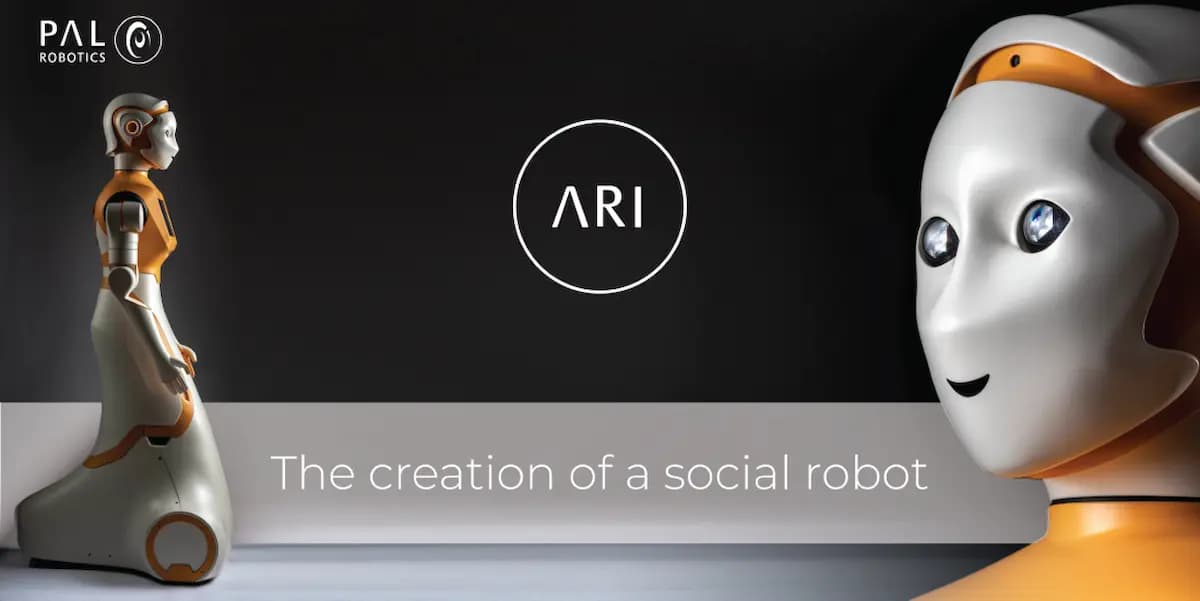ARI – The fully customisable humanoid social robot
3D printing brings endless possibilities to robotics design and development, and the creation and evolution of humanoid robot ARI is an example of this. The latest production technologies mean that future design developments to robot ARI, including options such as different cover colours and textures are much easier to achieve. This brings a huge range of possibilities for future development and allows us to customise ARI according to clients’ needs and to fit various applications- such as as a brand ambassador, or for a specific event. The team at PAL Robotics developed the social humanoid robot ARI in 2019.
We spoke with Tito Favaro, the Product Designer at PAL Robotics who created ARI, on his passion for robotics, how the robot has been able to evolve with the latest technology in production, and his future vision for robotics.
Tito told us, “Since I can remember I have always been passionate about robots, robotics and science fiction, so it is a pleasure to be part of the PAL Robotics team. PAL Robotics is a team that can design, engineer and manufacture any project from scratch. The diversity of professional profiles is great and the technological advances also bring a great number of possibilities. Being in such a context is a privilege.”
“I believe that we are getting closer and closer to technology such as robotics becoming more accessible. Every day at PAL Robotics we work on developing physical parts of a robot that imply the robot’s emotional acceptance, and that encourage a person to interact with a robot.”
“In addition, we work on making the management of a robot, such as ARI, accessible through the software, either by the type of platform used for programming, or by the type of GUI to manage its use. PAL Robotics works with the ROS (Robotics Operating System) open source framework to make it easier for researchers to advance.”
Read the interview to Raquel Ros about social robotics.
The origins of social robot ARI and inspiration from current technological references
Tito told us more about the origins of robot ARI and why the robot was created, “ARI was born as a technological revision of PAL Robotics’ REEM robot. To create ARI, we found inspiration in current technological references, in a new design of the original REEM robot proportions, and in simplifying the robot’s construction.”
Created in late 2019, ARI is a social humanoid robot that’s able to interact with people, talk, recognise faces, and offer the option of interacting via touchscreen. Robot ARI is made up of different materials, including various types of plastic. In initially creating the robot, the first ARI was fully 3D printed and the forearm was fixed, then later features were developed such as an actuated robot hand that was added to the robot. We then continued developing the robot hardware and software functionalities. Read more about how to use social robot ARI in your business.
ARI’s design has been based on the customer experience design method, following several steps along the way 1) discovery; to evaluate a suitable body-head proportion and degree of iconicity 2) prototype design; using mood board tendencies, colour and trim, clay modelling of the arm joints 3) creation, functional prototype using Materialise printing technology and 4) validation – carrying out a blueprint of the user experience. The main design considerations for robot ARI have been: mobility, a lightweight robot, safety, simplicity, a modern design.
Short and customisable production runs make robot ARI easy to update
Tito talked about the challenges in developing and manufacturing a robot such as ARI. “A challenge for us is that for a robot like ARI we need to manufacture approximately 50 pieces with sizes ranging from 20mm to 1200mm, with different materials and finishes, so it is not so easy to manage and secure a stock of parts, as well as control the costs.”
Tito continued to tell us about making a robot like ARI, “for us, the theme of making short and customisable production runs fits perfectly with the needs of researchers, who constantly seek to update the hardware on a robot, such as by adding new sensors or more powerful computers, and integrating them into platforms like ARI.”
Tito went on to explain, “3D printing originally emerged for the manufacture of highly customised prototypes and parts, and has evolved into general manufacturing in recent years. This is almost in parallel with our evolution as a company at PAL Robotics, since we need a lot of versatility to keep technologically updated, and every year we have new projects, so we are also close to the prototype process.”
Tito further explained, “With ARI we also take the initiative in various aspects related to production. A clear example is how the robot’s arms are manufactured, since they are structural and aesthetic pieces at the same time. For us, 3D printing of ARI’s arms is a way to reduce the number of parts, and also achieve a cosmetic proportion closer to what we are looking for.”
Tito added, “With ARI at the beginning, recent production techniques allow us to have a rapid prototype to validate many new decisions that we were not 100% clear about. We continue to carry out this same process in developing new accessories that our clients need.”
Check out the interview with Enrico Mingo Hoffman about the concrete real applications of humanoid robots.

Creation of ARI parts that are sustainable and a product that is continuously developing
Tito explained in further detail PAL Robotics’ partnership in 3D printing, “At PAL Robotics we work with Materialise who have helped us a lot with the finishes of the pieces. This makes our products much more sustainable, not only economically, but also environmentally.”
In terms of social robotics, Tito added the following insight, “market branches such as social robotics are focusing more on the product concept, that is one major reason why the concept of additive manufacturing has been increasingly fitting us into our processes towards the forefront of technology. We can continuously improve designs – due to time and flexibility, this is good for products that are always able to evolve”.
Read about ARI in hospitals for Project SPRING.
How additive manufacturing fits with the mission of PAL Robotics
Tito concluded, “The mission of PAL Robotics is for robotics to improve our daily lives – in order to do that we have to keep developing and improving our robots all the time to be able to better meet the needs of society – for that additive manufacturing is part of the exploration/discovery process so that robots have a place in our lives. We are convinced that robots will come to occupy a place in the daily lives of many people.”
“The development of ARI for me, is a reflection of PAL Robotics as a company. Every day I see colleagues facing complex decisions, and the most common response is to face them without fear, without fear of trying something new, always looking ahead and willing to try new things.”
If you want to know more about ARI, check out our answers to your questions and also take a look at our ARI’s FAQs.
We’d like to thank Tito Favaro for taking the time to talk with us. To find out more about PAL Robotics and social robot ARI, take a look at our blog about our work and research. Don’t hesitate to get in touch with our experts to ask more about how ARI the customizable social robot is ready to help meet your business needs.
Materialise was founded in 1990 and since then, they have created a range of software solutions and 3D printing services, which together form a backbone for the 3D printing industry, for industries such as healthcare, automotive, aerospace, art and design, and consumer goods.
